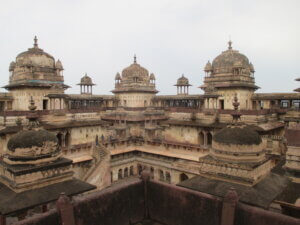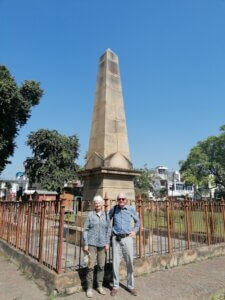Chairman’s Trip To India, February/March 2024 (Part 2)
Orchha, Khajuraho and Lucknow
Paul Dean, Chairman of BACSA, and his wife Moira recently visited several historical sites in India, as part of a long-awaited extended trip to mark their retirement. This post, the second in a series, covers places visited in Orchha, Khajuraho and Lucknow. A post about their visits to Hyderabad, Aurangabad and Agra was published on 11/05/2024. Future posts will cover their visits to Varanasi and Darjeeling.
Orchha
‘From Agra we went south to Gwalior, Datia and Orchha. In the latter two places it was astonishing to find not one but two palaces which had been built by the local Hindu ruler as gifts for Aurangzeb who stayed in them with his retinue for one night only when on a royal progress. Thereafter, we were told, they were left completely unoccupied. Both fabulous buildings, it seemed an extraordinary example of becoming surplus to requirements.
The other buildings in Orchha, which looked as though they got more use, were very striking and the group of royal chhatris on the banks of the River Betwa were profoundly moving. While in Orchha we were swamped on consecutive afternoons by storms, unforecast by the BBC and local weather apps, which severely tested the windows of our hotel in the palace complex. I found my slippers floating in a pool of water and both our wash bags, perched on a convenient windowsill, were soaked. We moved on to Khajuraho to dry out.

(Photo: P Dean, 2024)
Khajuraho
(Photo: P Dean, 2024)
After all the basalt and granite rock carvings in Karnataka and Maharashtra, it was fascinating to see the greater detail available to the masons when carving sandstone and what they did with it.
There is no doubt that the carvings at Khajuraho are something different, both in detail and content. It was entertaining not only to see what was going on before our own eyes, but also to see the reactions of the spectators in the carvings themselves to what was being graphically portrayed going on in front of their own eyes; there were looks of both horror and enjoyment.
After that, it was time to head north east to Lucknow.
Lucknow
General Sir Henry Havelock-Allan
(killed in the Khyber Pass in 1897)
(Photo: courtesy of P & M Dean, 2024)
You may have read on this website earlier in the year an article by the distinguished Australian military historian, Professor Peter Stanley, about his recent trip to India, in which he mentioned rereading Christopher Hibbert’s The Great Mutiny: India 1857 by way of preparation before visiting Lucknow. I chose instead to read BACSA’s own Rosie Llewellyn-Jones’ Lucknow 1857, published in India by Harper Collins in 2022, which fits conveniently into a pocket or a shoulder bag and is an excellent companion to the history and the sights, not just of the events of that year.
Rosie had arranged a tour in Lucknow for us with local tour operator, Tornos, run by BACSA member, Prateek Hira, to include, at our President’s request, a visit to his forefather’s grave to report back on its condition, so we had a busy schedule. Our guide was the excellent Pankaj, who was almost omniscient, save that when I gave him my card he guessed, when I couldn’t tell which was the cemetery featured on it, that it might be Kanpur, whereas assiduous readers of my earlier report will know it is the Roman Catholic Cemetery in Agra. On departure I gave Pankaj Rosie’s book, which Prateek tells me is now in the Tornos library. I have bought another copy!

In addition to Havelock’s grave, which we were able to report back was in excellent condition, we went to cemeteries at the Residency, which was peaceful and affecting; Nishatganj, where lies Walter Burley Griffin, the architect of Canberra, and the Mall Avenue, with quite a number of war graves better maintained by the CWGC than are the rest by the Lucknow Christian Burial Board.
Finally, we went to the Mariaon Cantonment Cemetery which has some beautiful old tombs, rather soullessly restored by the ASI.

(also known as ‘Constantia’)
(Photo: P Dean, 2024)
By now we felt more or less cemeteried out and it was, therefore, quite a relief to be taken to the extraordinary La Martinière College, built by the French soldier, Claude Martin (the subject of a biography by Rosie Llewellyn-Jones). It has something of the feel of a grandiose French chateau about it and houses Martin’s tomb in a crypt. After his death it became a boys school, which it remains.
During the Uprising the boys were moved to the Residency, and the building was used by the insurgents. While at the Residency, the pupils and staff behaved with such heroism that the school was awarded battle honours. These are recorded on a plaque under the central cupola. It is an unusual, if not a unique distinction.
Buried in the grounds is William Hodson of Hodson’s Horse fame, who died during the final relief of Lucknow in 1858. So, even here, we were surrounded by graves. On return to our hotel we went for a pizza to lighten the mood.
Next day we were taken to the station, where we waved goodbye to our driver Manoj and got on a train to Varanasi.’
Paul Dean
Ed. notes:
•Great Mutiny: India, 1857 by Christopher Hibbert was published by Allen Lane in 1978 (ISBN 978-0713910544)
•Lucknow 1857 by Rosie Llewellyn-Jones was published by Harper Collins in 2022 (ISBN 978-93-5489-405-3)
•‘The Havelock Grave at Alambagh’, an article in Chowkidar Vol 7 No 6, Autumn 1996, p.121, by Rosie Llewellyn-Jones, outlined Havelock’s role at Lucknow and highlighted concerns raised by BACSA member Arun Saksena about the condition of Havelock’s grave and the Alambagh Cemetery.
•‘An American in Lucknow’, a short article on Walter Burley Griffin (1876-1937), was published in Chowkidar Vol 5 No 1, Spring 1988, p1. A photo of Griffin’s grave at Nishatganj can be seen in Lucknow Cemeteries, a post by Prof Peter Stanley, published on 12/2/24.
•A Very Ingenious Man: Claude Martin in Early Colonial India by Rosie Llewellyn-Jones was published by Oxford University Press in 1999 (ISBN 0978-01-9565-099-0)
Rachel Magowan
(Suggestions for BACSA website news items are always welcome – please send them to ‘comms@bacsa.org.uk’)
